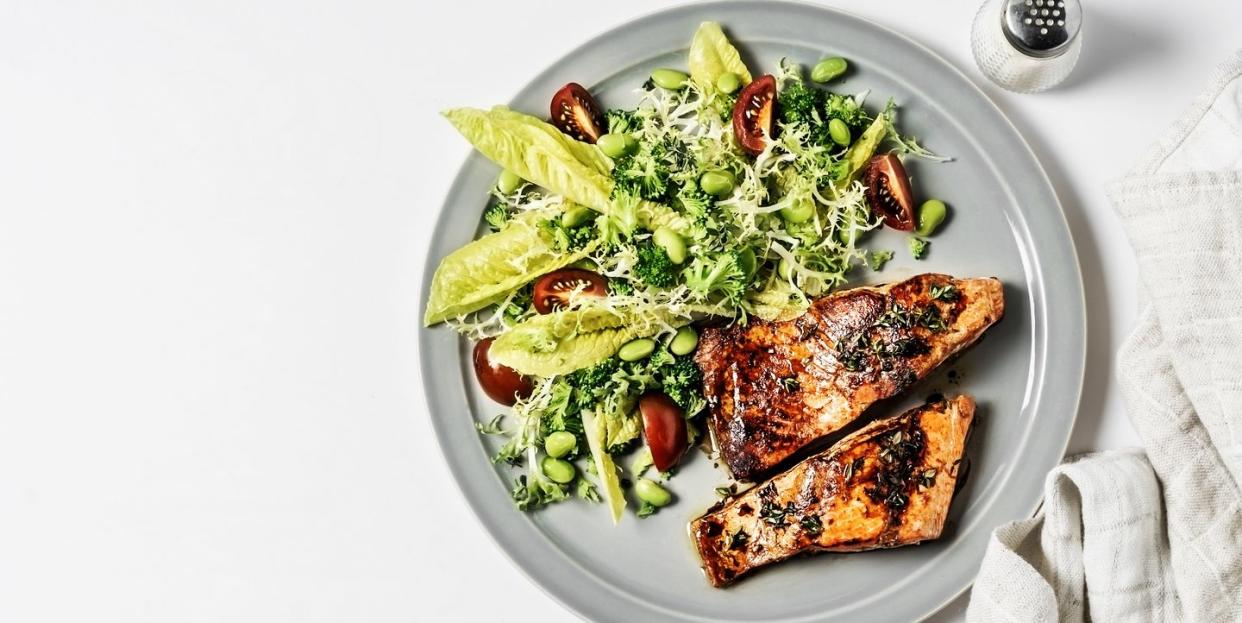Ever Wondered Exactly How to Build a Plate That Hits Your Health Goals?

Ever wondered precisely what makes a balanced meal? Sure: you learnt that a few servings of veg was a decent idea in nursery, but what about protein? Dairy? Starch?
In the UK, the office advice of a healthy diet comes courtesy of the NHS Eatwell Guide, which is based on advice from both the World Health Organisation and the Scientific Advisory Committee on Nutrition.
What is the official advice on building a balanced meal?
The guide is designed to show you what a healthy diet looks like over a period of a day or a week, rather than for each meal, because there are times when it’s useful to favour a particular macronutrient – a protein-rich breakfast has been shown to support weight loss, while carb-heavy meals post-workout can speed up recovery.
[We earn a commission for products purchased through some links in this article.]
According to the guide, a third of your diet should come from fruit and veg, and the NHS advises eating at least five portions a day. Notice the ‘at least’ – evidence is mounting for benefits of up to 10 portions, or 800g, a day.
As for the rest of your plate, it isn’t too prescriptive. Instead, we’re told to ‘base meals on starchy foods’, eat ‘some’ dairy, beans, pulses, fish, meat and eggs and consume unsaturated oils only in ‘small amounts’.
It’s intentionally vague – the ideal portion size depends on your individual body size, activity levels and weight goals. But the figures behind the guidelines do suggest that half of your daily calories should come from carbs.
Of this figure, less than 5% should come from added sugars, and your choices should help you reach the recommended intake of 30g of fibre daily.
Overwhelmed? Join the club. In 2016, scientists from the British Nutrition Foundation explored the real-world feasibility of these recommendations.
They found that it was possible to eat this way, but only if all meals were based on starchy foods (mainly wholegrain), daily fruit and veg intake amounted to eight portions and snacks were high-fibre.
As for protein, a palm-sized portion at each meal (plant or animal) will meet the recommended 0.8g per kilo of body weight per day, but there may be times when it’s beneficial to consume more, such as during weight loss or muscle gain.
And if you’re eschewing carbs in favour of protein, you might want to rethink, as low-carb diets are lower in fibre, the very stuff that protects against bowel cancer, heart disease and type-2 diabetes, as well as fertilising your microbiome.
For cooking and flavour, fats from olive oil, avocados, nuts and seeds are best.
How to build a balanced meal in 4 steps
1/ Start with two portions of fruit and veg (whole fruit, not juice, because #fibre).
2/ Next, add whole grains. Start with a cupped handful and increase portion sizes pre and post-exercise (between 0.8g and 1g per kilo of body weight after an intense workout).
3/ Add protein (larger portions at breakfast and post-workout)
4/ Finish with some dairy or a drizzle of healthy fat
In an IRL day, that might look like the below balanced meals.
A day of balanced meals
Breakfast
Eggs, wholegrain toast, avocado and spinach. The balance of protein, carbs and fat should keep your energy levels up till lunch.
Lunch
Mixed bean and quinoa salad with chicken or tofu. The balance of grains and protein will ward off the afternoon slump.
Dinner
Salmon with freekeh, butternut squash and stir-fried greens. Oily fish twice a week ticks off your omega-3 needs.
Now that you know what goes into a balanced meal, check out these healthy recipes from The Doctor's Kitchen.
You Might Also Like


